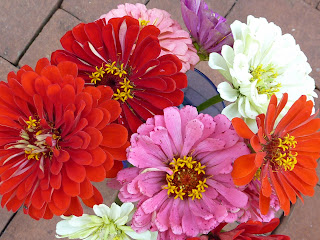This might be a sad thing if it weren't for zinnias, dubbed by the Victorian Age as the "Cinderella of the Garden," with their vivacious "flirtyness" wrapped up in a profuse rainbow of colors and sizes. Butterflies flock to them. Bumble Bees adore them and humans, well, we grow them for the same reasons, too.
 |
The genus, Zinnia is a member of the Sunflower Family (Asteracaea) and it's absence in our gardens symbolize just that in the language of flowers, being associated with thoughts of absent friends and loved ones. Zinnias represent goodness, lasting affection and daily remembrance, too. Any one of us can fondly recall picking zinnias in our grandparents garden as well as seeing bouquets of them brightening up our mother's kitchen table. How fitting for a flower that is so easy to grow, yet does not have a fleeting presence in our gardens but politely takes up residence and encourages those around it to stay and chat awhile, perhaps over the garden gate. There is not one stitch of jealousy to be found in a zinnia who only wants to compliment and show off its surroundings with sentiments that radiate fondness and friendliness making this popular heirloom a modern garden standard as well. Along with each color sprouts another nuance of this bodacious mid to late summer bloomer; yellow for daily remembrance, white for goodness, red (my favorite) for constancy and magenta for love and affection. I'm sure the list of its meanings grows as the pinwheel of zinnia colors expands.
 Originally, zinnias were native to Mexico. They were discovered by Spanish explorers who brought them back to Spain and the rest of Europe. However, the zinnias of that time were not the ruffled beauties they are today. Rather, they were dull and considered homely. In, fact the Mayans called them "mal de ojos" which means "eyesores." This feeling was also shared by most Europeans of the time who dubbed zinnias "everybody's flower" or "poorhouse flower." A German scientist and botanist by the name of Johann Zinn, who lived in the 1700's and whose hobby was breeding wildflowers, is credited with the first steps in transforming this cast-away weed into the pretty princess-like bloom that now graces flower beds and boarders everywhere. Hence, zinnia's common name, "Cinderella of the Garden," is a Cinderella story...complete with a happy ending for us all!
Originally, zinnias were native to Mexico. They were discovered by Spanish explorers who brought them back to Spain and the rest of Europe. However, the zinnias of that time were not the ruffled beauties they are today. Rather, they were dull and considered homely. In, fact the Mayans called them "mal de ojos" which means "eyesores." This feeling was also shared by most Europeans of the time who dubbed zinnias "everybody's flower" or "poorhouse flower." A German scientist and botanist by the name of Johann Zinn, who lived in the 1700's and whose hobby was breeding wildflowers, is credited with the first steps in transforming this cast-away weed into the pretty princess-like bloom that now graces flower beds and boarders everywhere. Hence, zinnia's common name, "Cinderella of the Garden," is a Cinderella story...complete with a happy ending for us all! |
| Pretty Thumbelina "Persian Carpet" |
There are those, I suppose,
who prefer to think of zinnias as stout,
standing stiff and stoic in their garden boarders but,
I prefer to picture zinnias as garden fairies' favorites.
frolicking gaily in their green and fancy skirts,
with their free-flowing "moppy" heads swaying in the wind.
Gathering memories to hold fast to
when cold days destined, are here and
Autumn's frost sends the zinnias away,
Until they reappear
on a mid-summer's day.
(by me, Cyndie
August, 2010)










I wonder how lovely the fragrance must be!
ReplyDelete